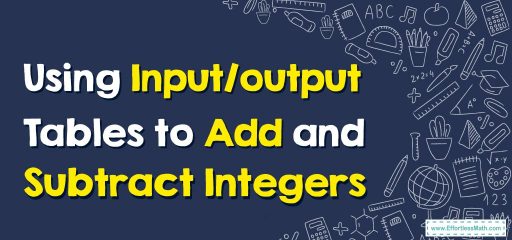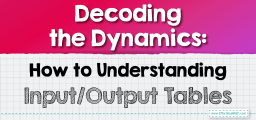How to Use Input/output Tables to Add and Subtract Integers?
Input/output tables are a useful tool for understanding the relationship between two sets of numbers. They can also be used to practice adding and subtracting integers.

A step-by-step guide to using input/output tables to add and subtract integers
Here is a step-by-step guide on how to use input/output tables to add and subtract integers:
Step 1: Understand the Table An input/output table is a table that shows the relationship between two sets of numbers. The input values are listed in one column, and the corresponding output values are listed in another column. It is important to understand the table’s structure and how the input and output values are related.
Step 2: Identify the Operation Look at the table to determine whether you are adding or subtracting integers. This will help you decide which sign to use when you write the expressions.
Step 3: Write the Expressions Write the expressions for each row in the table using the input value and the operation. For example, if the operation is addition, the expression would be:
\(input\) \(+ n =\) \(output\)
Where ‘\(n\)’ is the integer that needs to be added to the input to get the output.
Step 4: Solve for the Unknown Use algebraic methods to solve for the unknown integer ‘\(n\)’ in each row. You can do this by isolating ‘\(n\)’ on one side of the equation. For example, if the equation is:
\(input\) \(+ n =\) \(output\)
You can solve for ‘\(n\)’ by subtracting the input from both sides:
\(n = output – input\)
Step 5: Check Your Work Once you have solved for ‘\(n\)’ in each row, check your work by plugging in the input and ‘n’ values into the equation to see if they produce the correct output value.
Step 6: Practice, Practice, Practice! The more you practice using input/output tables to add and subtract integers, the easier it will become. Try creating your tables with different input and output values to challenge yourself.
Here’s an example to help illustrate these steps:
Example: Use an input/output table to add \(5\) to each input value.
| Input | Output |
|---|---|
| -4 | |
| -2 | |
| 1 | |
| 6 |
Step 1: Understand the Table This is an input/output table with the input values listed in the left column and the output values to be determined in the right column.
Step 2: Identify the Operation The operation is addition, so we will be adding \(5\) to each input value.
Step 3: Write the Expressions We can write the expressions for each row as:
\(-4 + 5 = output -2 + 5 = output 1 + 5 = output 6 + 5 = output\)
Step 4: Solve for the Unknown Solving for ‘\(n\)’ in each equation, we get:
\(-4 + 5 = 1, -2 + 5 = 3 ,1 + 5 = 6, 6 + 5 = 11\)
So the completed table looks like this:
| Input | Output |
|---|---|
| -4 | 1 |
| -2 | 3 |
| 1 | 6 |
| 6 | 11 |
Step 5: Check Your Work We can plug in the input and ‘\(n\)’ values into each equation to verify that they produce the correct output value. For example:
\(-4 + 5 = 1\)
Step 6: Practice, Practice, Practice! Try creating your own input/output tables with different operations and input/output values to further practice your skills.
Using Input/output Tables to Add and Subtract Integers – Example 1
Find out the rule to complete the table.
Solution:
Start with the number in the In column.
Figure out the rule to know whether you have to subtract or add to give the value shown in the Out column.
\(10-….. =-4\)
\(10+4=14\)
So, \(5-14=-9, 0-14=-14, -5-14=-19\)
The rule is IN\(-14=\)Out

Using Input/output Tables to Add and Subtract Integers – Example 2
Find out the rule to complete the table.
Solution:
Start with the number in the In column.
Figure out the rule to know whether you have to subtract or add to give the value shown in the Out column.
\(-7+….. =-2\)
\(-7+(-2)=5\)
So, \(-4+5=1, -1+5=4, 1+5=6\)
The rule is IN\(+5=\)Out

Related to This Article
More math articles
- 8th Grade PSSA Math Practice Test Questions
- 3rd Grade MAAP Math Worksheets: FREE & Printable
- FREE 7th Grade STAAR Math Practice Test
- 3rd Grade MCAS Math FREE Sample Practice Questions
- How to Solve Integers Inequalities involving Absolute Values?
- How to Add and Subtract Integers: Word Problems
- Full-Length 7th Grade IAR Math Practice Test
- 10 Most Common 6th Grade MAP Math Questions
- 7th Grade MAP Math Worksheets: FREE & Printable
- 3rd Grade MEA Math Worksheets: FREE & Printable


























What people say about "How to Use Input/output Tables to Add and Subtract Integers? - Effortless Math: We Help Students Learn to LOVE Mathematics"?
No one replied yet.